Telepharmacy: A Pharmacist's Perspective on the Clinical Benefits and Challenges
VerifiedAdded on 2023/06/06
|17
|4673
|435
AI Summary
This report discusses the benefits and challenges of telepharmacy, a method of distributing pharmaceutical care and products to patients in remote areas. The report found that telepharmacy helps patients receive clinical consultations and medicines, and can address health disparities in rural and remote populations. The report also discusses the different services provided by telepharmacy, such as drug therapy monitoring and patient counseling.
Contribute Materials
Your contribution can guide someone’s learning journey. Share your
documents today.

Running head: TELEPHARMACY
Pharmacy
Name of the Student
Name of the University
Author Note
Pharmacy
Name of the Student
Name of the University
Author Note
Secure Best Marks with AI Grader
Need help grading? Try our AI Grader for instant feedback on your assignments.
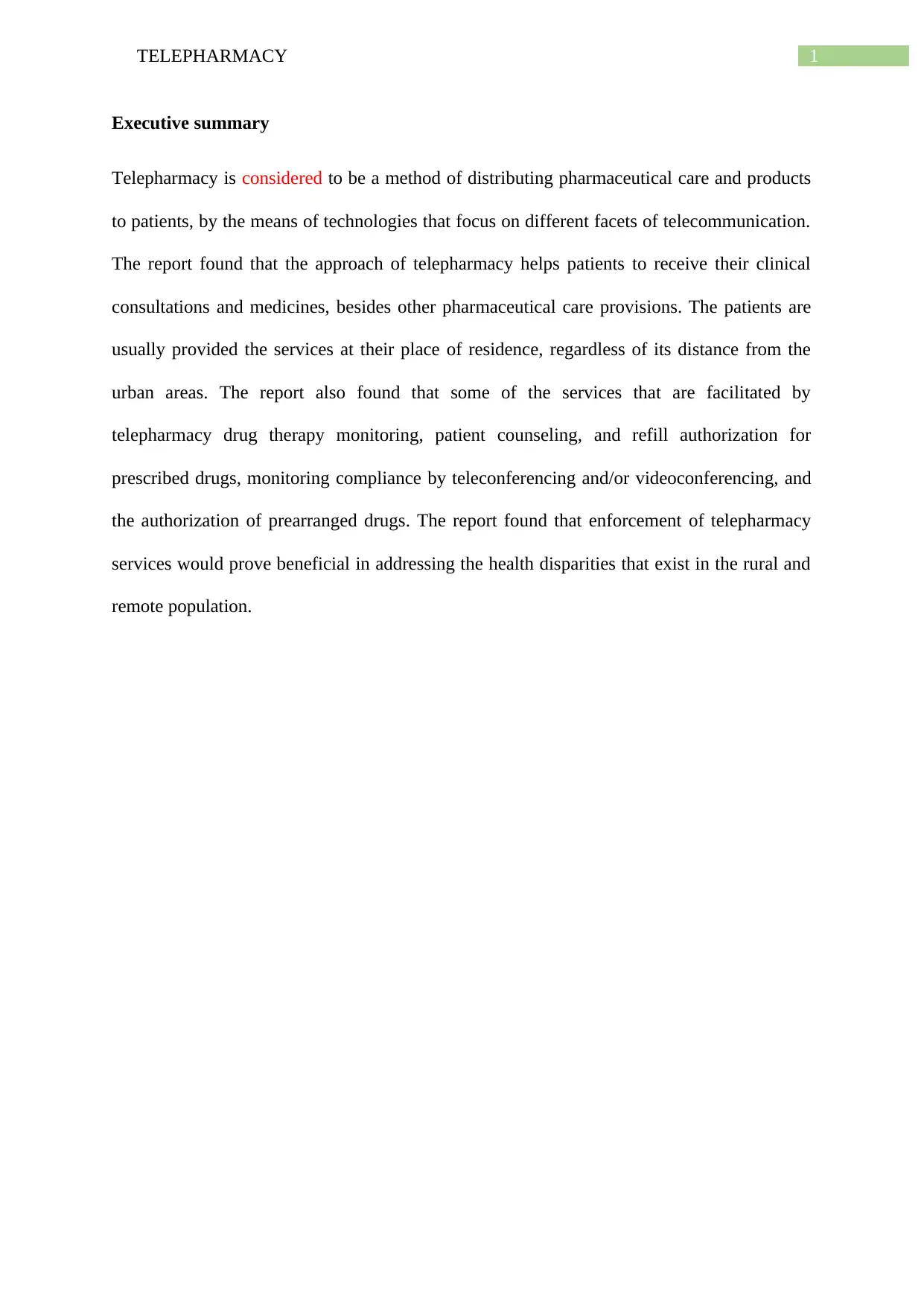
1TELEPHARMACY
Executive summary
Telepharmacy is considered to be a method of distributing pharmaceutical care and products
to patients, by the means of technologies that focus on different facets of telecommunication.
The report found that the approach of telepharmacy helps patients to receive their clinical
consultations and medicines, besides other pharmaceutical care provisions. The patients are
usually provided the services at their place of residence, regardless of its distance from the
urban areas. The report also found that some of the services that are facilitated by
telepharmacy drug therapy monitoring, patient counseling, and refill authorization for
prescribed drugs, monitoring compliance by teleconferencing and/or videoconferencing, and
the authorization of prearranged drugs. The report found that enforcement of telepharmacy
services would prove beneficial in addressing the health disparities that exist in the rural and
remote population.
Executive summary
Telepharmacy is considered to be a method of distributing pharmaceutical care and products
to patients, by the means of technologies that focus on different facets of telecommunication.
The report found that the approach of telepharmacy helps patients to receive their clinical
consultations and medicines, besides other pharmaceutical care provisions. The patients are
usually provided the services at their place of residence, regardless of its distance from the
urban areas. The report also found that some of the services that are facilitated by
telepharmacy drug therapy monitoring, patient counseling, and refill authorization for
prescribed drugs, monitoring compliance by teleconferencing and/or videoconferencing, and
the authorization of prearranged drugs. The report found that enforcement of telepharmacy
services would prove beneficial in addressing the health disparities that exist in the rural and
remote population.

2TELEPHARMACY
Table of Contents
Introduction................................................................................................................................3
Discussion of issue.....................................................................................................................4
Wakerman’s definition...............................................................................................................5
Issues identified..........................................................................................................................8
Recommendations and solutions................................................................................................9
Conclusion................................................................................................................................10
References................................................................................................................................12
Table of Contents
Introduction................................................................................................................................3
Discussion of issue.....................................................................................................................4
Wakerman’s definition...............................................................................................................5
Issues identified..........................................................................................................................8
Recommendations and solutions................................................................................................9
Conclusion................................................................................................................................10
References................................................................................................................................12
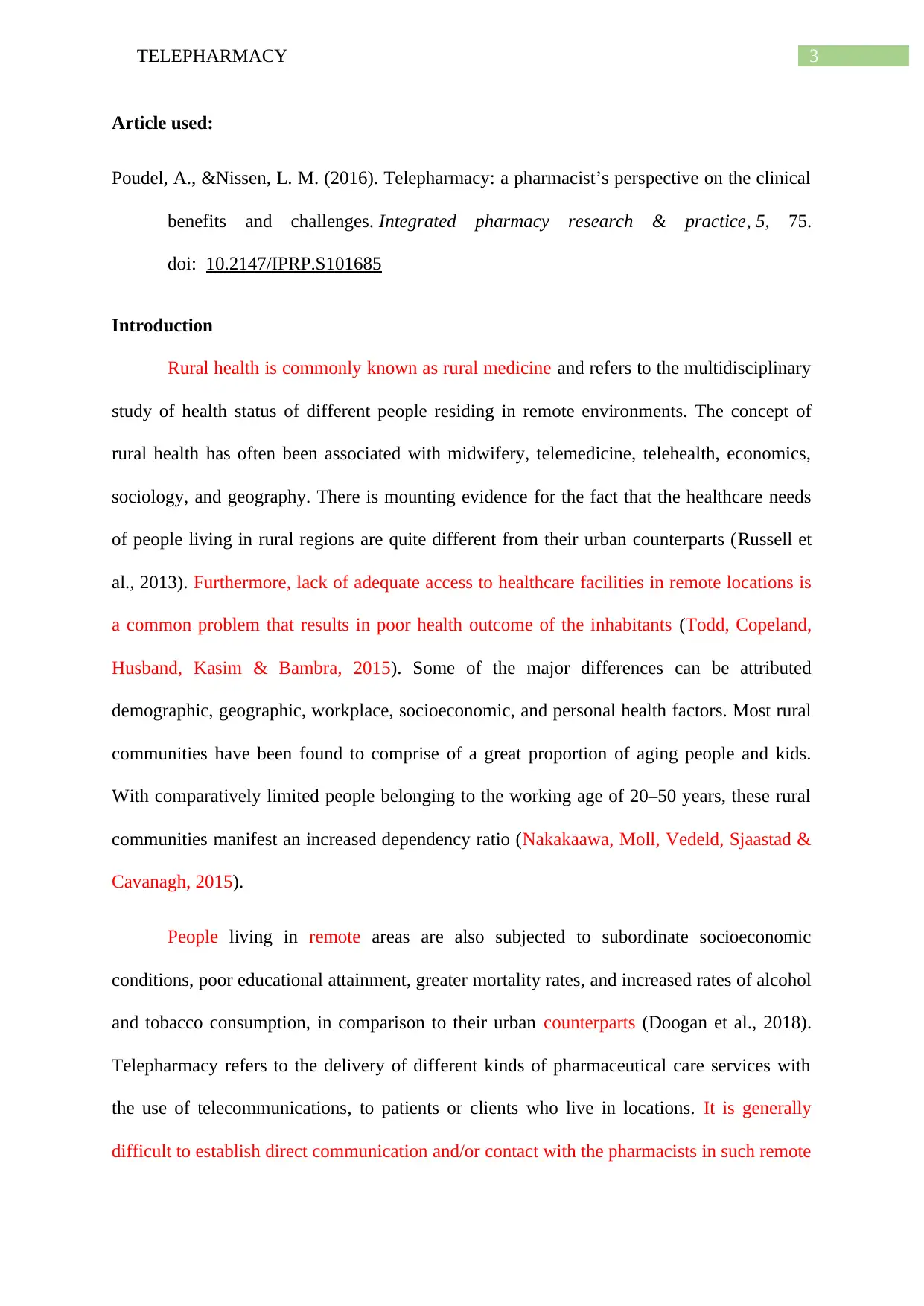
3TELEPHARMACY
Article used:
Poudel, A., &Nissen, L. M. (2016). Telepharmacy: a pharmacist’s perspective on the clinical
benefits and challenges. Integrated pharmacy research & practice, 5, 75.
doi: 10.2147/IPRP.S101685
Introduction
Rural health is commonly known as rural medicine and refers to the multidisciplinary
study of health status of different people residing in remote environments. The concept of
rural health has often been associated with midwifery, telemedicine, telehealth, economics,
sociology, and geography. There is mounting evidence for the fact that the healthcare needs
of people living in rural regions are quite different from their urban counterparts (Russell et
al., 2013). Furthermore, lack of adequate access to healthcare facilities in remote locations is
a common problem that results in poor health outcome of the inhabitants (Todd, Copeland,
Husband, Kasim & Bambra, 2015). Some of the major differences can be attributed
demographic, geographic, workplace, socioeconomic, and personal health factors. Most rural
communities have been found to comprise of a great proportion of aging people and kids.
With comparatively limited people belonging to the working age of 20–50 years, these rural
communities manifest an increased dependency ratio (Nakakaawa, Moll, Vedeld, Sjaastad &
Cavanagh, 2015).
People living in remote areas are also subjected to subordinate socioeconomic
conditions, poor educational attainment, greater mortality rates, and increased rates of alcohol
and tobacco consumption, in comparison to their urban counterparts (Doogan et al., 2018).
Telepharmacy refers to the delivery of different kinds of pharmaceutical care services with
the use of telecommunications, to patients or clients who live in locations. It is generally
difficult to establish direct communication and/or contact with the pharmacists in such remote
Article used:
Poudel, A., &Nissen, L. M. (2016). Telepharmacy: a pharmacist’s perspective on the clinical
benefits and challenges. Integrated pharmacy research & practice, 5, 75.
doi: 10.2147/IPRP.S101685
Introduction
Rural health is commonly known as rural medicine and refers to the multidisciplinary
study of health status of different people residing in remote environments. The concept of
rural health has often been associated with midwifery, telemedicine, telehealth, economics,
sociology, and geography. There is mounting evidence for the fact that the healthcare needs
of people living in rural regions are quite different from their urban counterparts (Russell et
al., 2013). Furthermore, lack of adequate access to healthcare facilities in remote locations is
a common problem that results in poor health outcome of the inhabitants (Todd, Copeland,
Husband, Kasim & Bambra, 2015). Some of the major differences can be attributed
demographic, geographic, workplace, socioeconomic, and personal health factors. Most rural
communities have been found to comprise of a great proportion of aging people and kids.
With comparatively limited people belonging to the working age of 20–50 years, these rural
communities manifest an increased dependency ratio (Nakakaawa, Moll, Vedeld, Sjaastad &
Cavanagh, 2015).
People living in remote areas are also subjected to subordinate socioeconomic
conditions, poor educational attainment, greater mortality rates, and increased rates of alcohol
and tobacco consumption, in comparison to their urban counterparts (Doogan et al., 2018).
Telepharmacy refers to the delivery of different kinds of pharmaceutical care services with
the use of telecommunications, to patients or clients who live in locations. It is generally
difficult to establish direct communication and/or contact with the pharmacists in such remote
Secure Best Marks with AI Grader
Need help grading? Try our AI Grader for instant feedback on your assignments.
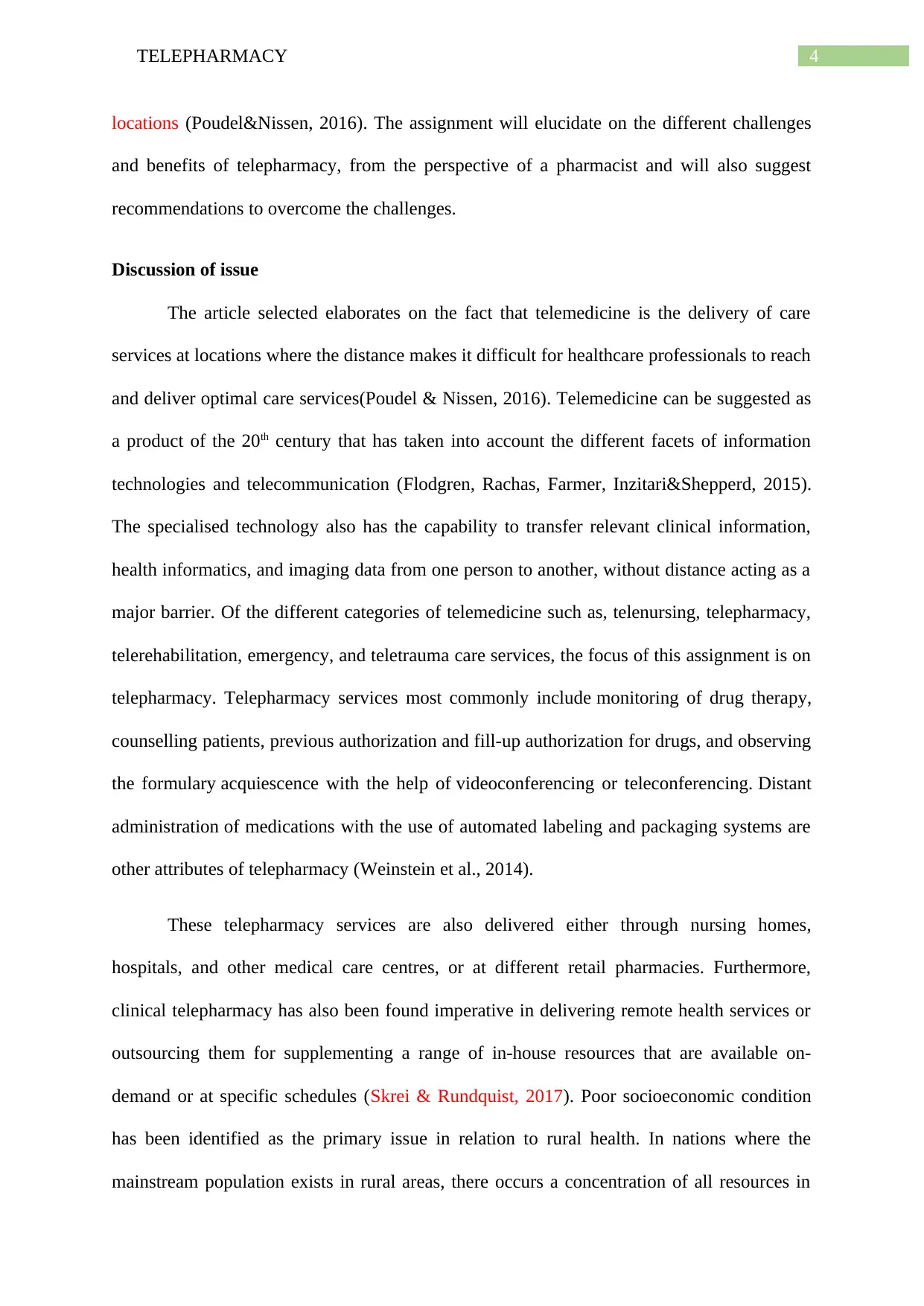
4TELEPHARMACY
locations (Poudel&Nissen, 2016). The assignment will elucidate on the different challenges
and benefits of telepharmacy, from the perspective of a pharmacist and will also suggest
recommendations to overcome the challenges.
Discussion of issue
The article selected elaborates on the fact that telemedicine is the delivery of care
services at locations where the distance makes it difficult for healthcare professionals to reach
and deliver optimal care services(Poudel & Nissen, 2016). Telemedicine can be suggested as
a product of the 20th century that has taken into account the different facets of information
technologies and telecommunication (Flodgren, Rachas, Farmer, Inzitari&Shepperd, 2015).
The specialised technology also has the capability to transfer relevant clinical information,
health informatics, and imaging data from one person to another, without distance acting as a
major barrier. Of the different categories of telemedicine such as, telenursing, telepharmacy,
telerehabilitation, emergency, and teletrauma care services, the focus of this assignment is on
telepharmacy. Telepharmacy services most commonly include monitoring of drug therapy,
counselling patients, previous authorization and fill-up authorization for drugs, and observing
the formulary acquiescence with the help of videoconferencing or teleconferencing. Distant
administration of medications with the use of automated labeling and packaging systems are
other attributes of telepharmacy (Weinstein et al., 2014).
These telepharmacy services are also delivered either through nursing homes,
hospitals, and other medical care centres, or at different retail pharmacies. Furthermore,
clinical telepharmacy has also been found imperative in delivering remote health services or
outsourcing them for supplementing a range of in-house resources that are available on-
demand or at specific schedules (Skrei & Rundquist, 2017). Poor socioeconomic condition
has been identified as the primary issue in relation to rural health. In nations where the
mainstream population exists in rural areas, there occurs a concentration of all resources in
locations (Poudel&Nissen, 2016). The assignment will elucidate on the different challenges
and benefits of telepharmacy, from the perspective of a pharmacist and will also suggest
recommendations to overcome the challenges.
Discussion of issue
The article selected elaborates on the fact that telemedicine is the delivery of care
services at locations where the distance makes it difficult for healthcare professionals to reach
and deliver optimal care services(Poudel & Nissen, 2016). Telemedicine can be suggested as
a product of the 20th century that has taken into account the different facets of information
technologies and telecommunication (Flodgren, Rachas, Farmer, Inzitari&Shepperd, 2015).
The specialised technology also has the capability to transfer relevant clinical information,
health informatics, and imaging data from one person to another, without distance acting as a
major barrier. Of the different categories of telemedicine such as, telenursing, telepharmacy,
telerehabilitation, emergency, and teletrauma care services, the focus of this assignment is on
telepharmacy. Telepharmacy services most commonly include monitoring of drug therapy,
counselling patients, previous authorization and fill-up authorization for drugs, and observing
the formulary acquiescence with the help of videoconferencing or teleconferencing. Distant
administration of medications with the use of automated labeling and packaging systems are
other attributes of telepharmacy (Weinstein et al., 2014).
These telepharmacy services are also delivered either through nursing homes,
hospitals, and other medical care centres, or at different retail pharmacies. Furthermore,
clinical telepharmacy has also been found imperative in delivering remote health services or
outsourcing them for supplementing a range of in-house resources that are available on-
demand or at specific schedules (Skrei & Rundquist, 2017). Poor socioeconomic condition
has been identified as the primary issue in relation to rural health. In nations where the
mainstream population exists in rural areas, there occurs a concentration of all resources in
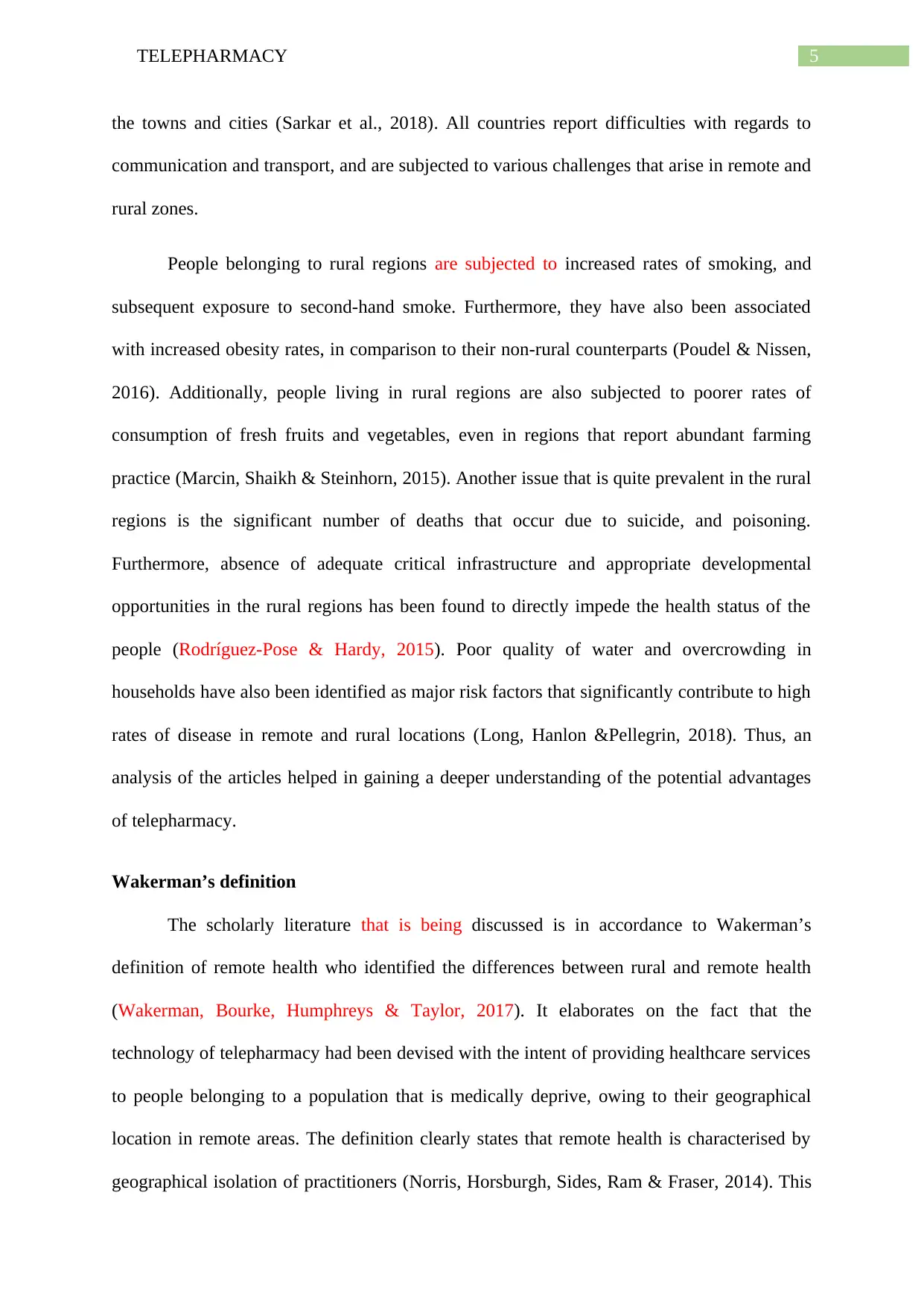
5TELEPHARMACY
the towns and cities (Sarkar et al., 2018). All countries report difficulties with regards to
communication and transport, and are subjected to various challenges that arise in remote and
rural zones.
People belonging to rural regions are subjected to increased rates of smoking, and
subsequent exposure to second-hand smoke. Furthermore, they have also been associated
with increased obesity rates, in comparison to their non-rural counterparts (Poudel & Nissen,
2016). Additionally, people living in rural regions are also subjected to poorer rates of
consumption of fresh fruits and vegetables, even in regions that report abundant farming
practice (Marcin, Shaikh & Steinhorn, 2015). Another issue that is quite prevalent in the rural
regions is the significant number of deaths that occur due to suicide, and poisoning.
Furthermore, absence of adequate critical infrastructure and appropriate developmental
opportunities in the rural regions has been found to directly impede the health status of the
people (Rodríguez-Pose & Hardy, 2015). Poor quality of water and overcrowding in
households have also been identified as major risk factors that significantly contribute to high
rates of disease in remote and rural locations (Long, Hanlon &Pellegrin, 2018). Thus, an
analysis of the articles helped in gaining a deeper understanding of the potential advantages
of telepharmacy.
Wakerman’s definition
The scholarly literature that is being discussed is in accordance to Wakerman’s
definition of remote health who identified the differences between rural and remote health
(Wakerman, Bourke, Humphreys & Taylor, 2017). It elaborates on the fact that the
technology of telepharmacy had been devised with the intent of providing healthcare services
to people belonging to a population that is medically deprive, owing to their geographical
location in remote areas. The definition clearly states that remote health is characterised by
geographical isolation of practitioners (Norris, Horsburgh, Sides, Ram & Fraser, 2014). This
the towns and cities (Sarkar et al., 2018). All countries report difficulties with regards to
communication and transport, and are subjected to various challenges that arise in remote and
rural zones.
People belonging to rural regions are subjected to increased rates of smoking, and
subsequent exposure to second-hand smoke. Furthermore, they have also been associated
with increased obesity rates, in comparison to their non-rural counterparts (Poudel & Nissen,
2016). Additionally, people living in rural regions are also subjected to poorer rates of
consumption of fresh fruits and vegetables, even in regions that report abundant farming
practice (Marcin, Shaikh & Steinhorn, 2015). Another issue that is quite prevalent in the rural
regions is the significant number of deaths that occur due to suicide, and poisoning.
Furthermore, absence of adequate critical infrastructure and appropriate developmental
opportunities in the rural regions has been found to directly impede the health status of the
people (Rodríguez-Pose & Hardy, 2015). Poor quality of water and overcrowding in
households have also been identified as major risk factors that significantly contribute to high
rates of disease in remote and rural locations (Long, Hanlon &Pellegrin, 2018). Thus, an
analysis of the articles helped in gaining a deeper understanding of the potential advantages
of telepharmacy.
Wakerman’s definition
The scholarly literature that is being discussed is in accordance to Wakerman’s
definition of remote health who identified the differences between rural and remote health
(Wakerman, Bourke, Humphreys & Taylor, 2017). It elaborates on the fact that the
technology of telepharmacy had been devised with the intent of providing healthcare services
to people belonging to a population that is medically deprive, owing to their geographical
location in remote areas. The definition clearly states that remote health is characterised by
geographical isolation of practitioners (Norris, Horsburgh, Sides, Ram & Fraser, 2014). This
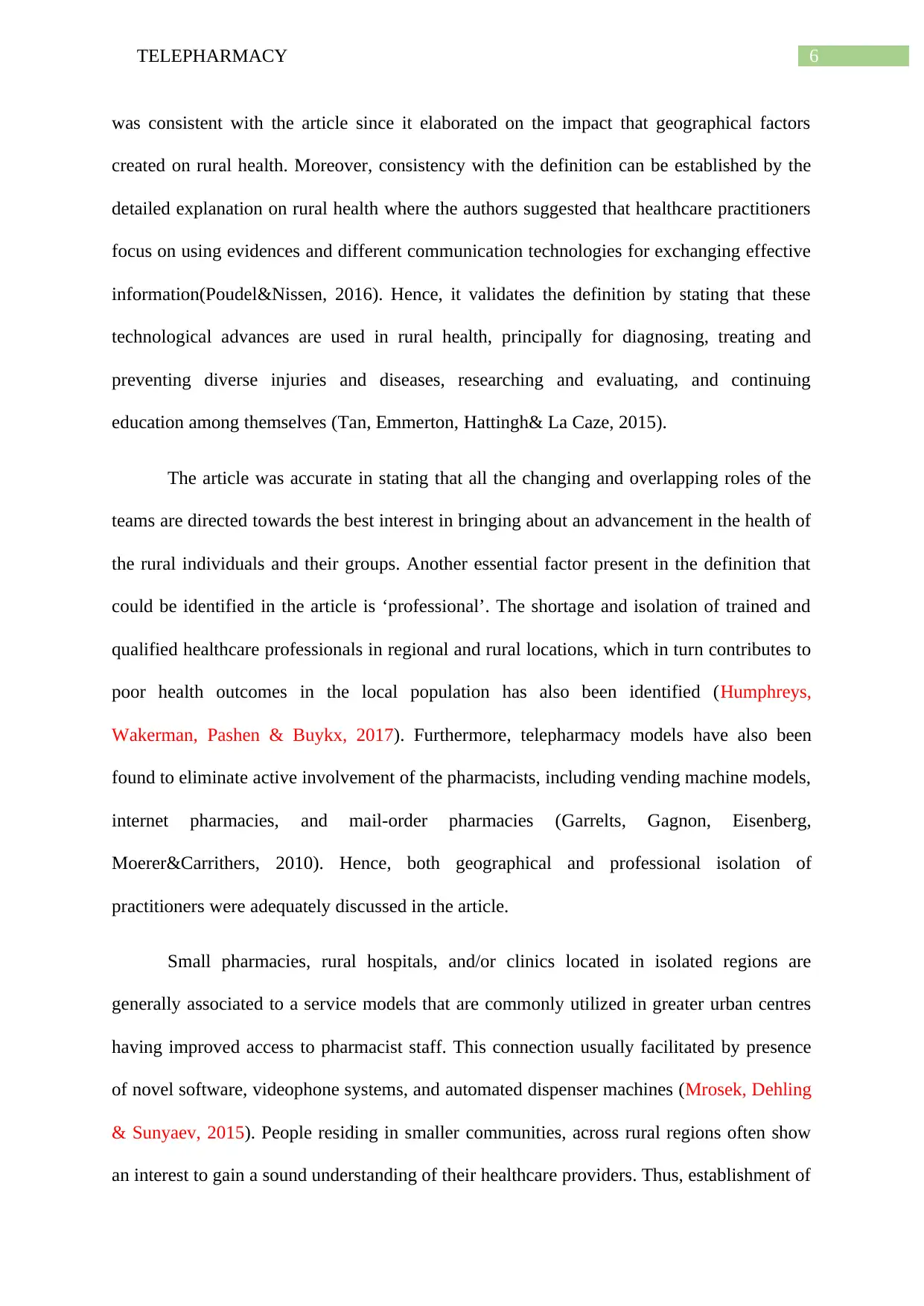
6TELEPHARMACY
was consistent with the article since it elaborated on the impact that geographical factors
created on rural health. Moreover, consistency with the definition can be established by the
detailed explanation on rural health where the authors suggested that healthcare practitioners
focus on using evidences and different communication technologies for exchanging effective
information(Poudel&Nissen, 2016). Hence, it validates the definition by stating that these
technological advances are used in rural health, principally for diagnosing, treating and
preventing diverse injuries and diseases, researching and evaluating, and continuing
education among themselves (Tan, Emmerton, Hattingh& La Caze, 2015).
The article was accurate in stating that all the changing and overlapping roles of the
teams are directed towards the best interest in bringing about an advancement in the health of
the rural individuals and their groups. Another essential factor present in the definition that
could be identified in the article is ‘professional’. The shortage and isolation of trained and
qualified healthcare professionals in regional and rural locations, which in turn contributes to
poor health outcomes in the local population has also been identified (Humphreys,
Wakerman, Pashen & Buykx, 2017). Furthermore, telepharmacy models have also been
found to eliminate active involvement of the pharmacists, including vending machine models,
internet pharmacies, and mail-order pharmacies (Garrelts, Gagnon, Eisenberg,
Moerer&Carrithers, 2010). Hence, both geographical and professional isolation of
practitioners were adequately discussed in the article.
Small pharmacies, rural hospitals, and/or clinics located in isolated regions are
generally associated to a service models that are commonly utilized in greater urban centres
having improved access to pharmacist staff. This connection usually facilitated by presence
of novel software, videophone systems, and automated dispenser machines (Mrosek, Dehling
& Sunyaev, 2015). People residing in smaller communities, across rural regions often show
an interest to gain a sound understanding of their healthcare providers. Thus, establishment of
was consistent with the article since it elaborated on the impact that geographical factors
created on rural health. Moreover, consistency with the definition can be established by the
detailed explanation on rural health where the authors suggested that healthcare practitioners
focus on using evidences and different communication technologies for exchanging effective
information(Poudel&Nissen, 2016). Hence, it validates the definition by stating that these
technological advances are used in rural health, principally for diagnosing, treating and
preventing diverse injuries and diseases, researching and evaluating, and continuing
education among themselves (Tan, Emmerton, Hattingh& La Caze, 2015).
The article was accurate in stating that all the changing and overlapping roles of the
teams are directed towards the best interest in bringing about an advancement in the health of
the rural individuals and their groups. Another essential factor present in the definition that
could be identified in the article is ‘professional’. The shortage and isolation of trained and
qualified healthcare professionals in regional and rural locations, which in turn contributes to
poor health outcomes in the local population has also been identified (Humphreys,
Wakerman, Pashen & Buykx, 2017). Furthermore, telepharmacy models have also been
found to eliminate active involvement of the pharmacists, including vending machine models,
internet pharmacies, and mail-order pharmacies (Garrelts, Gagnon, Eisenberg,
Moerer&Carrithers, 2010). Hence, both geographical and professional isolation of
practitioners were adequately discussed in the article.
Small pharmacies, rural hospitals, and/or clinics located in isolated regions are
generally associated to a service models that are commonly utilized in greater urban centres
having improved access to pharmacist staff. This connection usually facilitated by presence
of novel software, videophone systems, and automated dispenser machines (Mrosek, Dehling
& Sunyaev, 2015). People residing in smaller communities, across rural regions often show
an interest to gain a sound understanding of their healthcare providers. Thus, establishment of
Paraphrase This Document
Need a fresh take? Get an instant paraphrase of this document with our AI Paraphraser
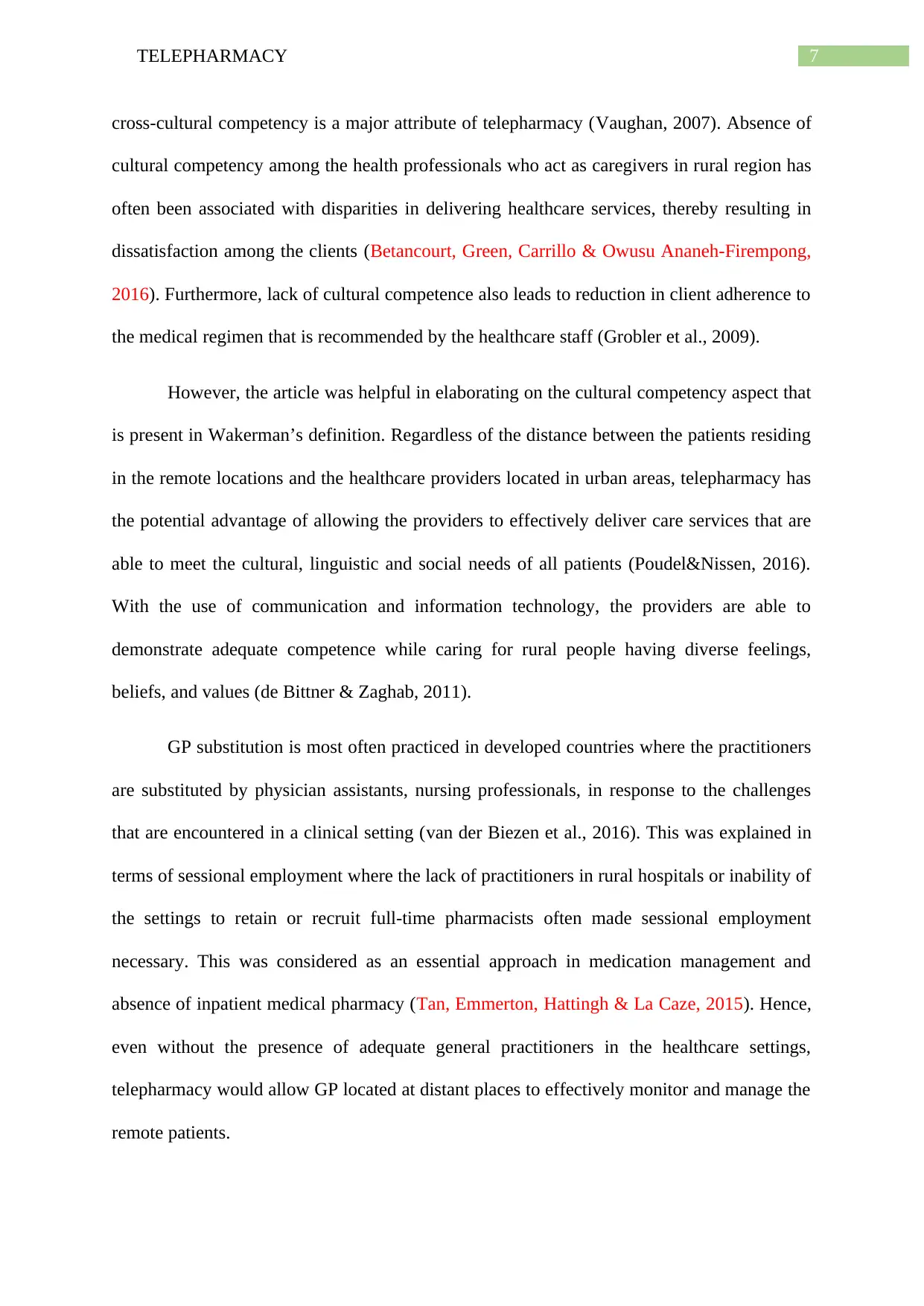
7TELEPHARMACY
cross-cultural competency is a major attribute of telepharmacy (Vaughan, 2007). Absence of
cultural competency among the health professionals who act as caregivers in rural region has
often been associated with disparities in delivering healthcare services, thereby resulting in
dissatisfaction among the clients (Betancourt, Green, Carrillo & Owusu Ananeh-Firempong,
2016). Furthermore, lack of cultural competence also leads to reduction in client adherence to
the medical regimen that is recommended by the healthcare staff (Grobler et al., 2009).
However, the article was helpful in elaborating on the cultural competency aspect that
is present in Wakerman’s definition. Regardless of the distance between the patients residing
in the remote locations and the healthcare providers located in urban areas, telepharmacy has
the potential advantage of allowing the providers to effectively deliver care services that are
able to meet the cultural, linguistic and social needs of all patients (Poudel&Nissen, 2016).
With the use of communication and information technology, the providers are able to
demonstrate adequate competence while caring for rural people having diverse feelings,
beliefs, and values (de Bittner & Zaghab, 2011).
GP substitution is most often practiced in developed countries where the practitioners
are substituted by physician assistants, nursing professionals, in response to the challenges
that are encountered in a clinical setting (van der Biezen et al., 2016). This was explained in
terms of sessional employment where the lack of practitioners in rural hospitals or inability of
the settings to retain or recruit full-time pharmacists often made sessional employment
necessary. This was considered as an essential approach in medication management and
absence of inpatient medical pharmacy (Tan, Emmerton, Hattingh & La Caze, 2015). Hence,
even without the presence of adequate general practitioners in the healthcare settings,
telepharmacy would allow GP located at distant places to effectively monitor and manage the
remote patients.
cross-cultural competency is a major attribute of telepharmacy (Vaughan, 2007). Absence of
cultural competency among the health professionals who act as caregivers in rural region has
often been associated with disparities in delivering healthcare services, thereby resulting in
dissatisfaction among the clients (Betancourt, Green, Carrillo & Owusu Ananeh-Firempong,
2016). Furthermore, lack of cultural competence also leads to reduction in client adherence to
the medical regimen that is recommended by the healthcare staff (Grobler et al., 2009).
However, the article was helpful in elaborating on the cultural competency aspect that
is present in Wakerman’s definition. Regardless of the distance between the patients residing
in the remote locations and the healthcare providers located in urban areas, telepharmacy has
the potential advantage of allowing the providers to effectively deliver care services that are
able to meet the cultural, linguistic and social needs of all patients (Poudel&Nissen, 2016).
With the use of communication and information technology, the providers are able to
demonstrate adequate competence while caring for rural people having diverse feelings,
beliefs, and values (de Bittner & Zaghab, 2011).
GP substitution is most often practiced in developed countries where the practitioners
are substituted by physician assistants, nursing professionals, in response to the challenges
that are encountered in a clinical setting (van der Biezen et al., 2016). This was explained in
terms of sessional employment where the lack of practitioners in rural hospitals or inability of
the settings to retain or recruit full-time pharmacists often made sessional employment
necessary. This was considered as an essential approach in medication management and
absence of inpatient medical pharmacy (Tan, Emmerton, Hattingh & La Caze, 2015). Hence,
even without the presence of adequate general practitioners in the healthcare settings,
telepharmacy would allow GP located at distant places to effectively monitor and manage the
remote patients.
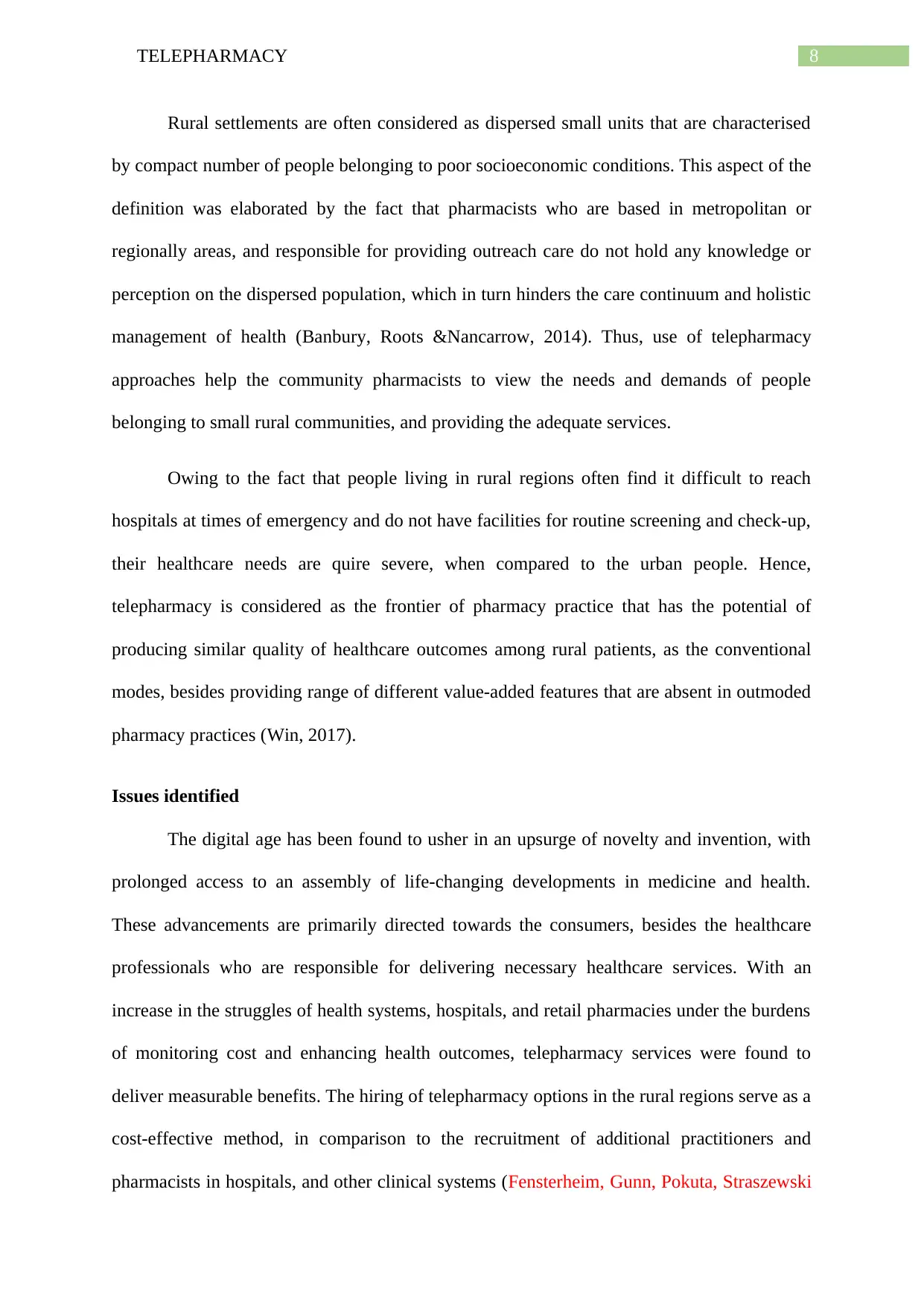
8TELEPHARMACY
Rural settlements are often considered as dispersed small units that are characterised
by compact number of people belonging to poor socioeconomic conditions. This aspect of the
definition was elaborated by the fact that pharmacists who are based in metropolitan or
regionally areas, and responsible for providing outreach care do not hold any knowledge or
perception on the dispersed population, which in turn hinders the care continuum and holistic
management of health (Banbury, Roots &Nancarrow, 2014). Thus, use of telepharmacy
approaches help the community pharmacists to view the needs and demands of people
belonging to small rural communities, and providing the adequate services.
Owing to the fact that people living in rural regions often find it difficult to reach
hospitals at times of emergency and do not have facilities for routine screening and check-up,
their healthcare needs are quire severe, when compared to the urban people. Hence,
telepharmacy is considered as the frontier of pharmacy practice that has the potential of
producing similar quality of healthcare outcomes among rural patients, as the conventional
modes, besides providing range of different value-added features that are absent in outmoded
pharmacy practices (Win, 2017).
Issues identified
The digital age has been found to usher in an upsurge of novelty and invention, with
prolonged access to an assembly of life-changing developments in medicine and health.
These advancements are primarily directed towards the consumers, besides the healthcare
professionals who are responsible for delivering necessary healthcare services. With an
increase in the struggles of health systems, hospitals, and retail pharmacies under the burdens
of monitoring cost and enhancing health outcomes, telepharmacy services were found to
deliver measurable benefits. The hiring of telepharmacy options in the rural regions serve as a
cost-effective method, in comparison to the recruitment of additional practitioners and
pharmacists in hospitals, and other clinical systems (Fensterheim, Gunn, Pokuta, Straszewski
Rural settlements are often considered as dispersed small units that are characterised
by compact number of people belonging to poor socioeconomic conditions. This aspect of the
definition was elaborated by the fact that pharmacists who are based in metropolitan or
regionally areas, and responsible for providing outreach care do not hold any knowledge or
perception on the dispersed population, which in turn hinders the care continuum and holistic
management of health (Banbury, Roots &Nancarrow, 2014). Thus, use of telepharmacy
approaches help the community pharmacists to view the needs and demands of people
belonging to small rural communities, and providing the adequate services.
Owing to the fact that people living in rural regions often find it difficult to reach
hospitals at times of emergency and do not have facilities for routine screening and check-up,
their healthcare needs are quire severe, when compared to the urban people. Hence,
telepharmacy is considered as the frontier of pharmacy practice that has the potential of
producing similar quality of healthcare outcomes among rural patients, as the conventional
modes, besides providing range of different value-added features that are absent in outmoded
pharmacy practices (Win, 2017).
Issues identified
The digital age has been found to usher in an upsurge of novelty and invention, with
prolonged access to an assembly of life-changing developments in medicine and health.
These advancements are primarily directed towards the consumers, besides the healthcare
professionals who are responsible for delivering necessary healthcare services. With an
increase in the struggles of health systems, hospitals, and retail pharmacies under the burdens
of monitoring cost and enhancing health outcomes, telepharmacy services were found to
deliver measurable benefits. The hiring of telepharmacy options in the rural regions serve as a
cost-effective method, in comparison to the recruitment of additional practitioners and
pharmacists in hospitals, and other clinical systems (Fensterheim, Gunn, Pokuta, Straszewski
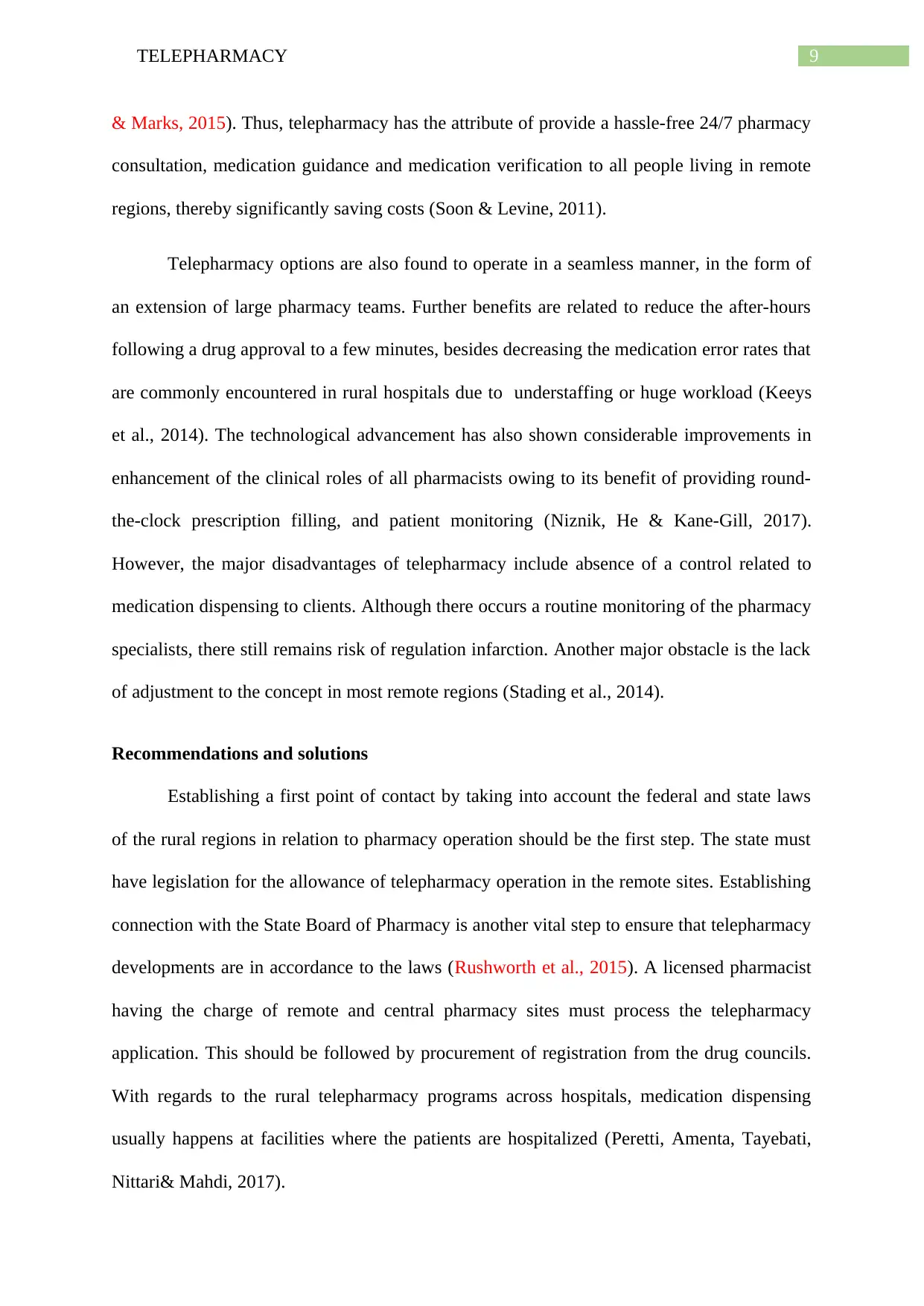
9TELEPHARMACY
& Marks, 2015). Thus, telepharmacy has the attribute of provide a hassle-free 24/7 pharmacy
consultation, medication guidance and medication verification to all people living in remote
regions, thereby significantly saving costs (Soon & Levine, 2011).
Telepharmacy options are also found to operate in a seamless manner, in the form of
an extension of large pharmacy teams. Further benefits are related to reduce the after-hours
following a drug approval to a few minutes, besides decreasing the medication error rates that
are commonly encountered in rural hospitals due to understaffing or huge workload (Keeys
et al., 2014). The technological advancement has also shown considerable improvements in
enhancement of the clinical roles of all pharmacists owing to its benefit of providing round-
the-clock prescription filling, and patient monitoring (Niznik, He & Kane-Gill, 2017).
However, the major disadvantages of telepharmacy include absence of a control related to
medication dispensing to clients. Although there occurs a routine monitoring of the pharmacy
specialists, there still remains risk of regulation infarction. Another major obstacle is the lack
of adjustment to the concept in most remote regions (Stading et al., 2014).
Recommendations and solutions
Establishing a first point of contact by taking into account the federal and state laws
of the rural regions in relation to pharmacy operation should be the first step. The state must
have legislation for the allowance of telepharmacy operation in the remote sites. Establishing
connection with the State Board of Pharmacy is another vital step to ensure that telepharmacy
developments are in accordance to the laws (Rushworth et al., 2015). A licensed pharmacist
having the charge of remote and central pharmacy sites must process the telepharmacy
application. This should be followed by procurement of registration from the drug councils.
With regards to the rural telepharmacy programs across hospitals, medication dispensing
usually happens at facilities where the patients are hospitalized (Peretti, Amenta, Tayebati,
Nittari& Mahdi, 2017).
& Marks, 2015). Thus, telepharmacy has the attribute of provide a hassle-free 24/7 pharmacy
consultation, medication guidance and medication verification to all people living in remote
regions, thereby significantly saving costs (Soon & Levine, 2011).
Telepharmacy options are also found to operate in a seamless manner, in the form of
an extension of large pharmacy teams. Further benefits are related to reduce the after-hours
following a drug approval to a few minutes, besides decreasing the medication error rates that
are commonly encountered in rural hospitals due to understaffing or huge workload (Keeys
et al., 2014). The technological advancement has also shown considerable improvements in
enhancement of the clinical roles of all pharmacists owing to its benefit of providing round-
the-clock prescription filling, and patient monitoring (Niznik, He & Kane-Gill, 2017).
However, the major disadvantages of telepharmacy include absence of a control related to
medication dispensing to clients. Although there occurs a routine monitoring of the pharmacy
specialists, there still remains risk of regulation infarction. Another major obstacle is the lack
of adjustment to the concept in most remote regions (Stading et al., 2014).
Recommendations and solutions
Establishing a first point of contact by taking into account the federal and state laws
of the rural regions in relation to pharmacy operation should be the first step. The state must
have legislation for the allowance of telepharmacy operation in the remote sites. Establishing
connection with the State Board of Pharmacy is another vital step to ensure that telepharmacy
developments are in accordance to the laws (Rushworth et al., 2015). A licensed pharmacist
having the charge of remote and central pharmacy sites must process the telepharmacy
application. This should be followed by procurement of registration from the drug councils.
With regards to the rural telepharmacy programs across hospitals, medication dispensing
usually happens at facilities where the patients are hospitalized (Peretti, Amenta, Tayebati,
Nittari& Mahdi, 2017).
Secure Best Marks with AI Grader
Need help grading? Try our AI Grader for instant feedback on your assignments.

10TELEPHARMACY
Claims must be submitted by the hospitals for patient care, without affecting the
reimbursement practices. Provision must also be created for the hospitals to enter contractual
agreements and pay dues to the telepharmacy programs for the health services they obtain.
Operation of a telepharmacy program under the experienced equipment-driven supervision of
licensed pharmacists would be another major approach in this regard. Delegation of a
dispensing model that gives the prescription processing information to different non-
pharmacist healthcare specialists is another future potential for implementation of
telepharmacy services. Provisions for off-site prescription verification must also be created in
order to better facilitate recordkeeping (Le, Toscani&Colaizzi, 2018).
Assessing the primary health needs of the rural population that is being offered the
telepharmacy service should be determined for the program feasibility. Addressing questions
related to availability of pharmacy services in the community, presence of health personnel,
convenience of a cost-effective location, and support for establishing the telepharmacy
service are imperative in the process (Pratt, 2015). Furthermore, efforts must also be taken to
assess the willingness of the concerned licensed pharmacist and effectiveness of a business
plan for assessment of the projected revenue and expenses. Seeking help from the rural health
personnel, community business leaders, local government, officials, and state pharmaceutical
association is crucial. Other recommendations should encompass securing a proper physical
location prior to planning the construction (Tzanetakos, Ullrich&Meuller, 2017).
Conclusion
Thus it can be concluded, people living in rural societies are considered as the
disadvantaged population, in comparison to cities that contains adequate hospitals, ambulance
services, and emergency departments. In comparison, people residing in the rural areas are
often more focused on their needs and sense of security. This need is most commonly
expressed in terms of the community’s chief focus on enlisting and retaining a doctor or
Claims must be submitted by the hospitals for patient care, without affecting the
reimbursement practices. Provision must also be created for the hospitals to enter contractual
agreements and pay dues to the telepharmacy programs for the health services they obtain.
Operation of a telepharmacy program under the experienced equipment-driven supervision of
licensed pharmacists would be another major approach in this regard. Delegation of a
dispensing model that gives the prescription processing information to different non-
pharmacist healthcare specialists is another future potential for implementation of
telepharmacy services. Provisions for off-site prescription verification must also be created in
order to better facilitate recordkeeping (Le, Toscani&Colaizzi, 2018).
Assessing the primary health needs of the rural population that is being offered the
telepharmacy service should be determined for the program feasibility. Addressing questions
related to availability of pharmacy services in the community, presence of health personnel,
convenience of a cost-effective location, and support for establishing the telepharmacy
service are imperative in the process (Pratt, 2015). Furthermore, efforts must also be taken to
assess the willingness of the concerned licensed pharmacist and effectiveness of a business
plan for assessment of the projected revenue and expenses. Seeking help from the rural health
personnel, community business leaders, local government, officials, and state pharmaceutical
association is crucial. Other recommendations should encompass securing a proper physical
location prior to planning the construction (Tzanetakos, Ullrich&Meuller, 2017).
Conclusion
Thus it can be concluded, people living in rural societies are considered as the
disadvantaged population, in comparison to cities that contains adequate hospitals, ambulance
services, and emergency departments. In comparison, people residing in the rural areas are
often more focused on their needs and sense of security. This need is most commonly
expressed in terms of the community’s chief focus on enlisting and retaining a doctor or
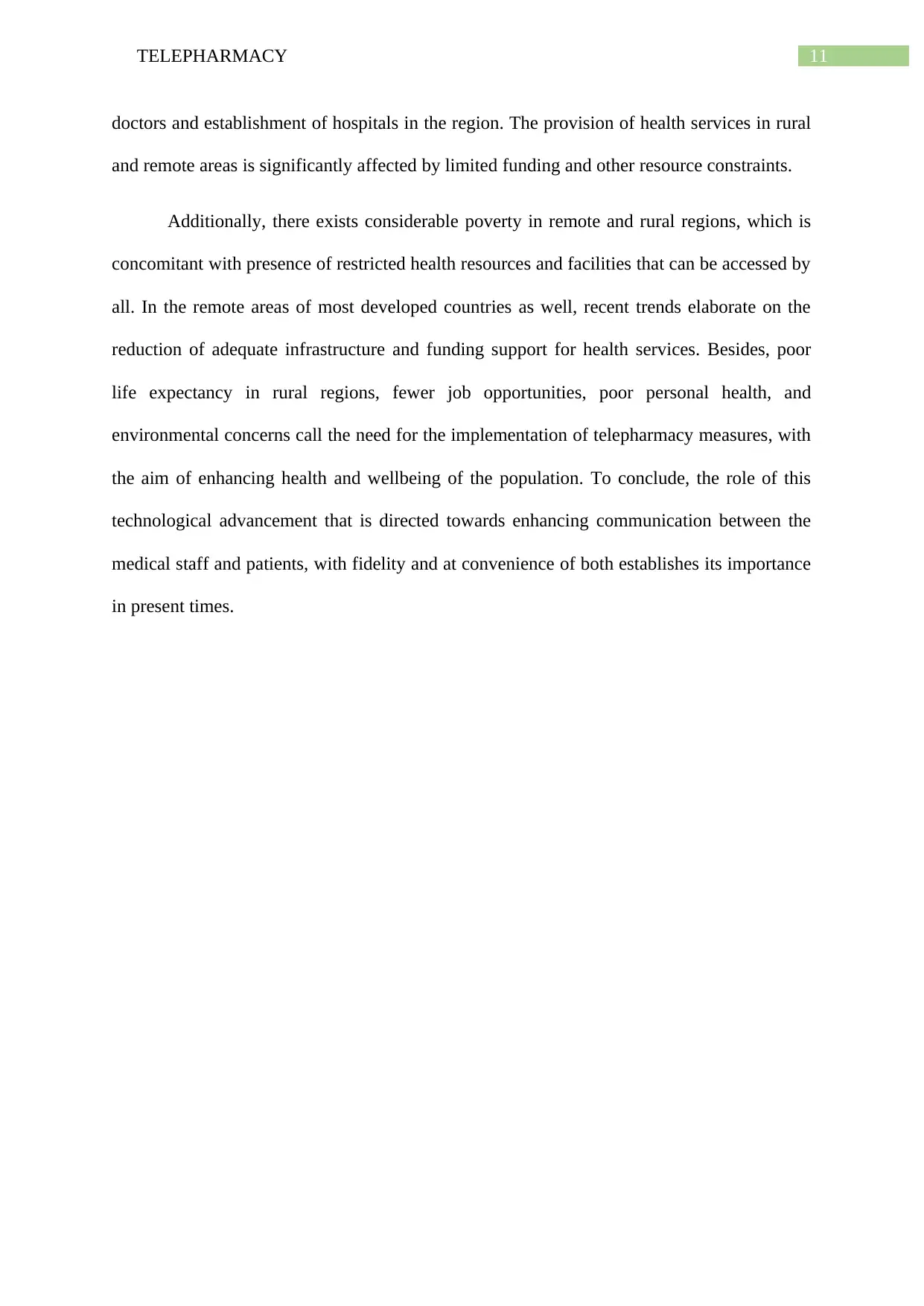
11TELEPHARMACY
doctors and establishment of hospitals in the region. The provision of health services in rural
and remote areas is significantly affected by limited funding and other resource constraints.
Additionally, there exists considerable poverty in remote and rural regions, which is
concomitant with presence of restricted health resources and facilities that can be accessed by
all. In the remote areas of most developed countries as well, recent trends elaborate on the
reduction of adequate infrastructure and funding support for health services. Besides, poor
life expectancy in rural regions, fewer job opportunities, poor personal health, and
environmental concerns call the need for the implementation of telepharmacy measures, with
the aim of enhancing health and wellbeing of the population. To conclude, the role of this
technological advancement that is directed towards enhancing communication between the
medical staff and patients, with fidelity and at convenience of both establishes its importance
in present times.
doctors and establishment of hospitals in the region. The provision of health services in rural
and remote areas is significantly affected by limited funding and other resource constraints.
Additionally, there exists considerable poverty in remote and rural regions, which is
concomitant with presence of restricted health resources and facilities that can be accessed by
all. In the remote areas of most developed countries as well, recent trends elaborate on the
reduction of adequate infrastructure and funding support for health services. Besides, poor
life expectancy in rural regions, fewer job opportunities, poor personal health, and
environmental concerns call the need for the implementation of telepharmacy measures, with
the aim of enhancing health and wellbeing of the population. To conclude, the role of this
technological advancement that is directed towards enhancing communication between the
medical staff and patients, with fidelity and at convenience of both establishes its importance
in present times.
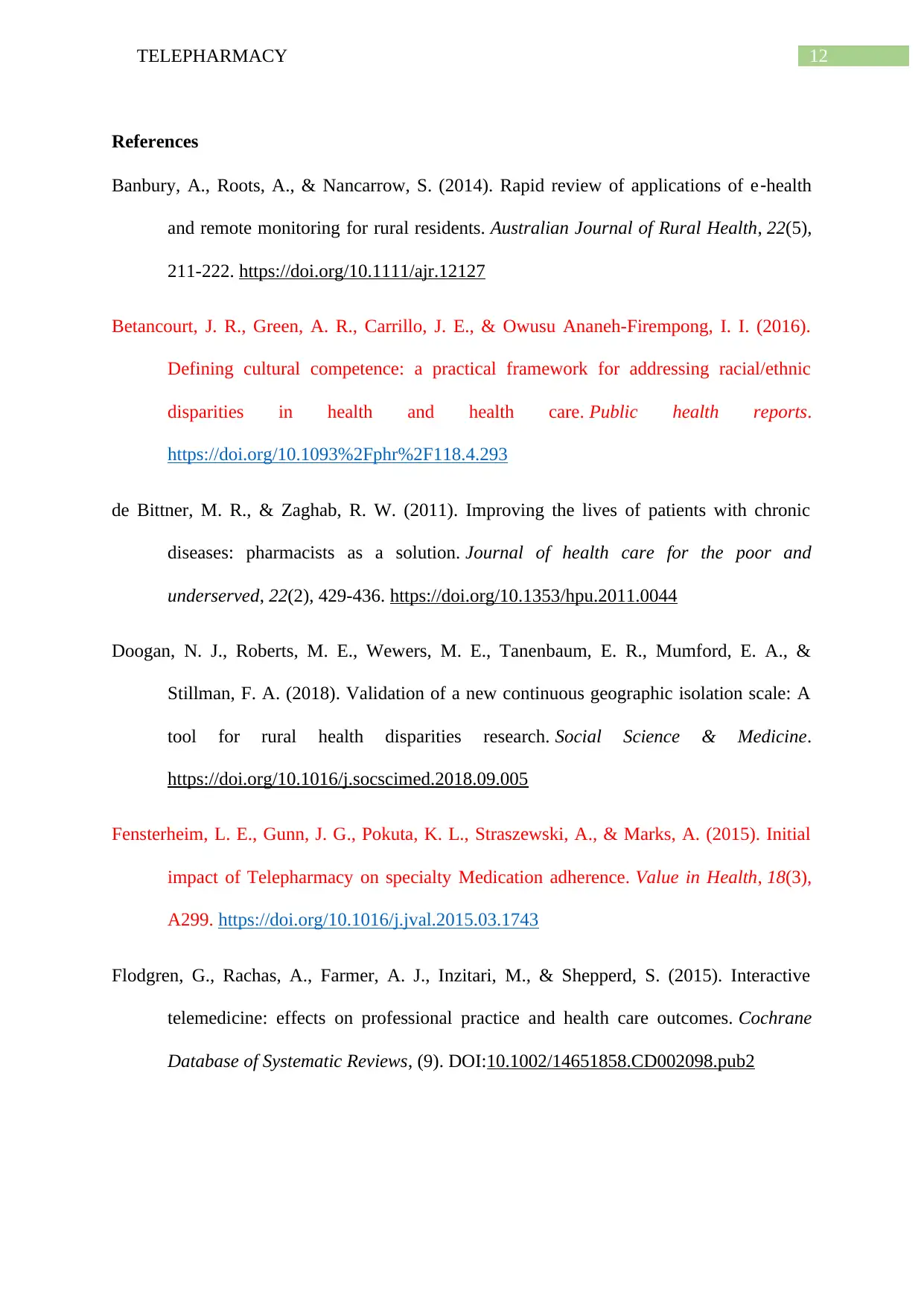
12TELEPHARMACY
References
Banbury, A., Roots, A., & Nancarrow, S. (2014). Rapid review of applications of e‐health
and remote monitoring for rural residents. Australian Journal of Rural Health, 22(5),
211-222. https://doi.org/10.1111/ajr.12127
Betancourt, J. R., Green, A. R., Carrillo, J. E., & Owusu Ananeh-Firempong, I. I. (2016).
Defining cultural competence: a practical framework for addressing racial/ethnic
disparities in health and health care. Public health reports.
https://doi.org/10.1093%2Fphr%2F118.4.293
de Bittner, M. R., & Zaghab, R. W. (2011). Improving the lives of patients with chronic
diseases: pharmacists as a solution. Journal of health care for the poor and
underserved, 22(2), 429-436. https://doi.org/10.1353/hpu.2011.0044
Doogan, N. J., Roberts, M. E., Wewers, M. E., Tanenbaum, E. R., Mumford, E. A., &
Stillman, F. A. (2018). Validation of a new continuous geographic isolation scale: A
tool for rural health disparities research. Social Science & Medicine.
https://doi.org/10.1016/j.socscimed.2018.09.005
Fensterheim, L. E., Gunn, J. G., Pokuta, K. L., Straszewski, A., & Marks, A. (2015). Initial
impact of Telepharmacy on specialty Medication adherence. Value in Health, 18(3),
A299. https://doi.org/10.1016/j.jval.2015.03.1743
Flodgren, G., Rachas, A., Farmer, A. J., Inzitari, M., & Shepperd, S. (2015). Interactive
telemedicine: effects on professional practice and health care outcomes. Cochrane
Database of Systematic Reviews, (9). DOI:10.1002/14651858.CD002098.pub2
References
Banbury, A., Roots, A., & Nancarrow, S. (2014). Rapid review of applications of e‐health
and remote monitoring for rural residents. Australian Journal of Rural Health, 22(5),
211-222. https://doi.org/10.1111/ajr.12127
Betancourt, J. R., Green, A. R., Carrillo, J. E., & Owusu Ananeh-Firempong, I. I. (2016).
Defining cultural competence: a practical framework for addressing racial/ethnic
disparities in health and health care. Public health reports.
https://doi.org/10.1093%2Fphr%2F118.4.293
de Bittner, M. R., & Zaghab, R. W. (2011). Improving the lives of patients with chronic
diseases: pharmacists as a solution. Journal of health care for the poor and
underserved, 22(2), 429-436. https://doi.org/10.1353/hpu.2011.0044
Doogan, N. J., Roberts, M. E., Wewers, M. E., Tanenbaum, E. R., Mumford, E. A., &
Stillman, F. A. (2018). Validation of a new continuous geographic isolation scale: A
tool for rural health disparities research. Social Science & Medicine.
https://doi.org/10.1016/j.socscimed.2018.09.005
Fensterheim, L. E., Gunn, J. G., Pokuta, K. L., Straszewski, A., & Marks, A. (2015). Initial
impact of Telepharmacy on specialty Medication adherence. Value in Health, 18(3),
A299. https://doi.org/10.1016/j.jval.2015.03.1743
Flodgren, G., Rachas, A., Farmer, A. J., Inzitari, M., & Shepperd, S. (2015). Interactive
telemedicine: effects on professional practice and health care outcomes. Cochrane
Database of Systematic Reviews, (9). DOI:10.1002/14651858.CD002098.pub2
Paraphrase This Document
Need a fresh take? Get an instant paraphrase of this document with our AI Paraphraser

13TELEPHARMACY
Garrelts, J. C., Gagnon, M., Eisenberg, C., Moerer, J., & Carrithers, J. (2010). Impact of
telepharmacy in a multihospital health system. American Journal of Health-System
Pharmacy, 67(17), 1456-1462. https://doi.org/10.2146/ajhp090670
Grobler, L., Marais, B. J., Mabunda, S. A., Marindi, P. N., Reuter, H., & Volmink, J. (2009).
Interventions for increasing the proportion of health professionals practising in rural
and other underserved areas. Cochrane Database Syst Rev, 1(1). DOI:
10.1002/14651858.CD005314.pub2.
Humphreys, J., Wakerman, J., Pashen, D., & Buykx, P. (2017). Retention strategies and
incentives for health workers in rural and remote areas: what works?. Retrieved from
https://openresearchrepository.anu.edu.au/bitstream/1885/119206/1/
humphreys_international_retention_key_findings_pdf_38421(1).pdf
Keeys, C., Kalejaiye, B., Skinner, M., Eimen, M., Neufer, J., Sidbury, G., ...& Vincent, J.
(2014). Pharmacist-managed inpatient discharge medication reconciliation: a
combined onsite and telepharmacy model. American Journal of Health-System
Pharmacy, 71(24), 2159-2166. https://doi.org/10.2146/ajhp130650
Long, A. S., Hanlon, A. L., & Pellegrin, K. L. (2018). Socioeconomic Variables Explain
Rural Disparities in US Mortality Rates: Implications for Rural Health Research and
Policy. SSM-population health. https://doi.org/10.1016/j.ssmph.2018.08.009
Marcin, J. P., Shaikh, U., & Steinhorn, R. H. (2015). Addressing health disparities in rural
communities using telehealth. Pediatric Research, 79(1-2), 169.
https://doi.org/10.1038/pr.2015.192
Mrosek, R., Dehling, T., & Sunyaev, A. (2015). Taxonomy of health IT and medication
adherence. Health Policy and Technology, 4(3), 215-224.
https://doi.org/10.1016/j.hlpt.2015.04.003
Garrelts, J. C., Gagnon, M., Eisenberg, C., Moerer, J., & Carrithers, J. (2010). Impact of
telepharmacy in a multihospital health system. American Journal of Health-System
Pharmacy, 67(17), 1456-1462. https://doi.org/10.2146/ajhp090670
Grobler, L., Marais, B. J., Mabunda, S. A., Marindi, P. N., Reuter, H., & Volmink, J. (2009).
Interventions for increasing the proportion of health professionals practising in rural
and other underserved areas. Cochrane Database Syst Rev, 1(1). DOI:
10.1002/14651858.CD005314.pub2.
Humphreys, J., Wakerman, J., Pashen, D., & Buykx, P. (2017). Retention strategies and
incentives for health workers in rural and remote areas: what works?. Retrieved from
https://openresearchrepository.anu.edu.au/bitstream/1885/119206/1/
humphreys_international_retention_key_findings_pdf_38421(1).pdf
Keeys, C., Kalejaiye, B., Skinner, M., Eimen, M., Neufer, J., Sidbury, G., ...& Vincent, J.
(2014). Pharmacist-managed inpatient discharge medication reconciliation: a
combined onsite and telepharmacy model. American Journal of Health-System
Pharmacy, 71(24), 2159-2166. https://doi.org/10.2146/ajhp130650
Long, A. S., Hanlon, A. L., & Pellegrin, K. L. (2018). Socioeconomic Variables Explain
Rural Disparities in US Mortality Rates: Implications for Rural Health Research and
Policy. SSM-population health. https://doi.org/10.1016/j.ssmph.2018.08.009
Marcin, J. P., Shaikh, U., & Steinhorn, R. H. (2015). Addressing health disparities in rural
communities using telehealth. Pediatric Research, 79(1-2), 169.
https://doi.org/10.1038/pr.2015.192
Mrosek, R., Dehling, T., & Sunyaev, A. (2015). Taxonomy of health IT and medication
adherence. Health Policy and Technology, 4(3), 215-224.
https://doi.org/10.1016/j.hlpt.2015.04.003
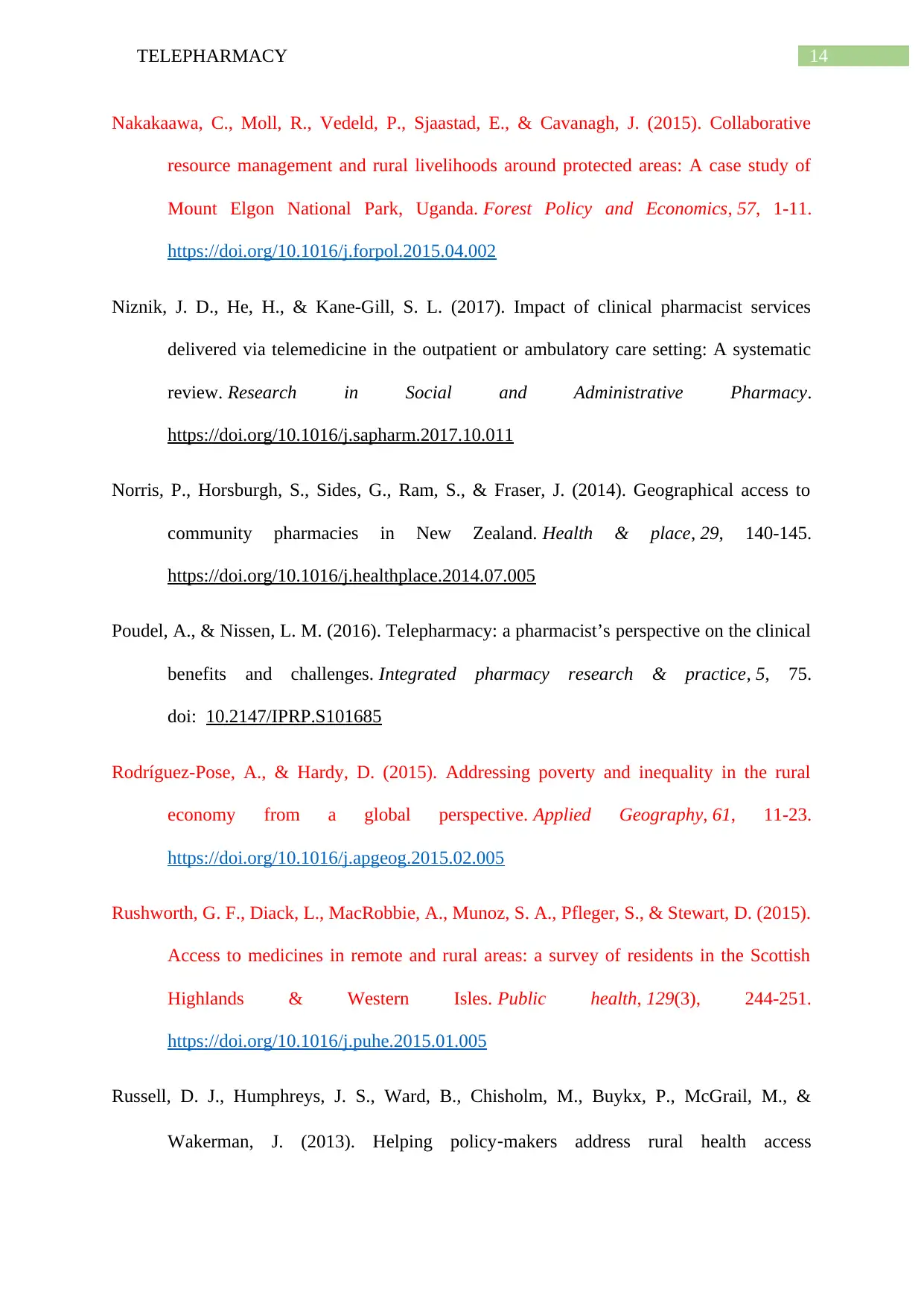
14TELEPHARMACY
Nakakaawa, C., Moll, R., Vedeld, P., Sjaastad, E., & Cavanagh, J. (2015). Collaborative
resource management and rural livelihoods around protected areas: A case study of
Mount Elgon National Park, Uganda. Forest Policy and Economics, 57, 1-11.
https://doi.org/10.1016/j.forpol.2015.04.002
Niznik, J. D., He, H., & Kane-Gill, S. L. (2017). Impact of clinical pharmacist services
delivered via telemedicine in the outpatient or ambulatory care setting: A systematic
review. Research in Social and Administrative Pharmacy.
https://doi.org/10.1016/j.sapharm.2017.10.011
Norris, P., Horsburgh, S., Sides, G., Ram, S., & Fraser, J. (2014). Geographical access to
community pharmacies in New Zealand. Health & place, 29, 140-145.
https://doi.org/10.1016/j.healthplace.2014.07.005
Poudel, A., & Nissen, L. M. (2016). Telepharmacy: a pharmacist’s perspective on the clinical
benefits and challenges. Integrated pharmacy research & practice, 5, 75.
doi: 10.2147/IPRP.S101685
Rodríguez-Pose, A., & Hardy, D. (2015). Addressing poverty and inequality in the rural
economy from a global perspective. Applied Geography, 61, 11-23.
https://doi.org/10.1016/j.apgeog.2015.02.005
Rushworth, G. F., Diack, L., MacRobbie, A., Munoz, S. A., Pfleger, S., & Stewart, D. (2015).
Access to medicines in remote and rural areas: a survey of residents in the Scottish
Highlands & Western Isles. Public health, 129(3), 244-251.
https://doi.org/10.1016/j.puhe.2015.01.005
Russell, D. J., Humphreys, J. S., Ward, B., Chisholm, M., Buykx, P., McGrail, M., &
Wakerman, J. (2013). Helping policy‐makers address rural health access
Nakakaawa, C., Moll, R., Vedeld, P., Sjaastad, E., & Cavanagh, J. (2015). Collaborative
resource management and rural livelihoods around protected areas: A case study of
Mount Elgon National Park, Uganda. Forest Policy and Economics, 57, 1-11.
https://doi.org/10.1016/j.forpol.2015.04.002
Niznik, J. D., He, H., & Kane-Gill, S. L. (2017). Impact of clinical pharmacist services
delivered via telemedicine in the outpatient or ambulatory care setting: A systematic
review. Research in Social and Administrative Pharmacy.
https://doi.org/10.1016/j.sapharm.2017.10.011
Norris, P., Horsburgh, S., Sides, G., Ram, S., & Fraser, J. (2014). Geographical access to
community pharmacies in New Zealand. Health & place, 29, 140-145.
https://doi.org/10.1016/j.healthplace.2014.07.005
Poudel, A., & Nissen, L. M. (2016). Telepharmacy: a pharmacist’s perspective on the clinical
benefits and challenges. Integrated pharmacy research & practice, 5, 75.
doi: 10.2147/IPRP.S101685
Rodríguez-Pose, A., & Hardy, D. (2015). Addressing poverty and inequality in the rural
economy from a global perspective. Applied Geography, 61, 11-23.
https://doi.org/10.1016/j.apgeog.2015.02.005
Rushworth, G. F., Diack, L., MacRobbie, A., Munoz, S. A., Pfleger, S., & Stewart, D. (2015).
Access to medicines in remote and rural areas: a survey of residents in the Scottish
Highlands & Western Isles. Public health, 129(3), 244-251.
https://doi.org/10.1016/j.puhe.2015.01.005
Russell, D. J., Humphreys, J. S., Ward, B., Chisholm, M., Buykx, P., McGrail, M., &
Wakerman, J. (2013). Helping policy‐makers address rural health access
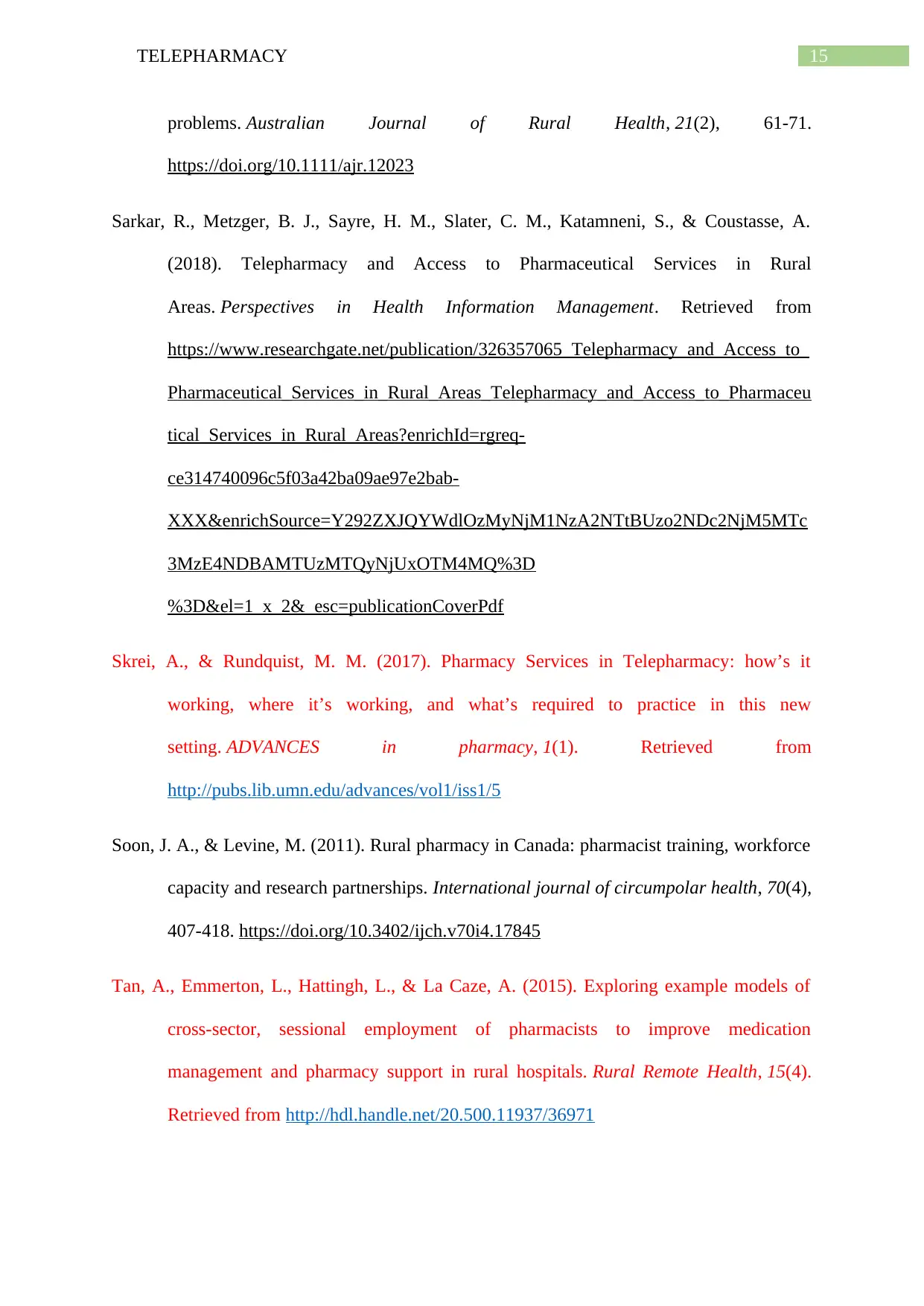
15TELEPHARMACY
problems. Australian Journal of Rural Health, 21(2), 61-71.
https://doi.org/10.1111/ajr.12023
Sarkar, R., Metzger, B. J., Sayre, H. M., Slater, C. M., Katamneni, S., & Coustasse, A.
(2018). Telepharmacy and Access to Pharmaceutical Services in Rural
Areas. Perspectives in Health Information Management. Retrieved from
https://www.researchgate.net/publication/326357065_Telepharmacy_and_Access_to_
Pharmaceutical_Services_in_Rural_Areas_Telepharmacy_and_Access_to_Pharmaceu
tical_Services_in_Rural_Areas?enrichId=rgreq-
ce314740096c5f03a42ba09ae97e2bab-
XXX&enrichSource=Y292ZXJQYWdlOzMyNjM1NzA2NTtBUzo2NDc2NjM5MTc
3MzE4NDBAMTUzMTQyNjUxOTM4MQ%3D
%3D&el=1_x_2&_esc=publicationCoverPdf
Skrei, A., & Rundquist, M. M. (2017). Pharmacy Services in Telepharmacy: how’s it
working, where it’s working, and what’s required to practice in this new
setting. ADVANCES in pharmacy, 1(1). Retrieved from
http://pubs.lib.umn.edu/advances/vol1/iss1/5
Soon, J. A., & Levine, M. (2011). Rural pharmacy in Canada: pharmacist training, workforce
capacity and research partnerships. International journal of circumpolar health, 70(4),
407-418. https://doi.org/10.3402/ijch.v70i4.17845
Tan, A., Emmerton, L., Hattingh, L., & La Caze, A. (2015). Exploring example models of
cross-sector, sessional employment of pharmacists to improve medication
management and pharmacy support in rural hospitals. Rural Remote Health, 15(4).
Retrieved from http://hdl.handle.net/20.500.11937/36971
problems. Australian Journal of Rural Health, 21(2), 61-71.
https://doi.org/10.1111/ajr.12023
Sarkar, R., Metzger, B. J., Sayre, H. M., Slater, C. M., Katamneni, S., & Coustasse, A.
(2018). Telepharmacy and Access to Pharmaceutical Services in Rural
Areas. Perspectives in Health Information Management. Retrieved from
https://www.researchgate.net/publication/326357065_Telepharmacy_and_Access_to_
Pharmaceutical_Services_in_Rural_Areas_Telepharmacy_and_Access_to_Pharmaceu
tical_Services_in_Rural_Areas?enrichId=rgreq-
ce314740096c5f03a42ba09ae97e2bab-
XXX&enrichSource=Y292ZXJQYWdlOzMyNjM1NzA2NTtBUzo2NDc2NjM5MTc
3MzE4NDBAMTUzMTQyNjUxOTM4MQ%3D
%3D&el=1_x_2&_esc=publicationCoverPdf
Skrei, A., & Rundquist, M. M. (2017). Pharmacy Services in Telepharmacy: how’s it
working, where it’s working, and what’s required to practice in this new
setting. ADVANCES in pharmacy, 1(1). Retrieved from
http://pubs.lib.umn.edu/advances/vol1/iss1/5
Soon, J. A., & Levine, M. (2011). Rural pharmacy in Canada: pharmacist training, workforce
capacity and research partnerships. International journal of circumpolar health, 70(4),
407-418. https://doi.org/10.3402/ijch.v70i4.17845
Tan, A., Emmerton, L., Hattingh, L., & La Caze, A. (2015). Exploring example models of
cross-sector, sessional employment of pharmacists to improve medication
management and pharmacy support in rural hospitals. Rural Remote Health, 15(4).
Retrieved from http://hdl.handle.net/20.500.11937/36971
Secure Best Marks with AI Grader
Need help grading? Try our AI Grader for instant feedback on your assignments.
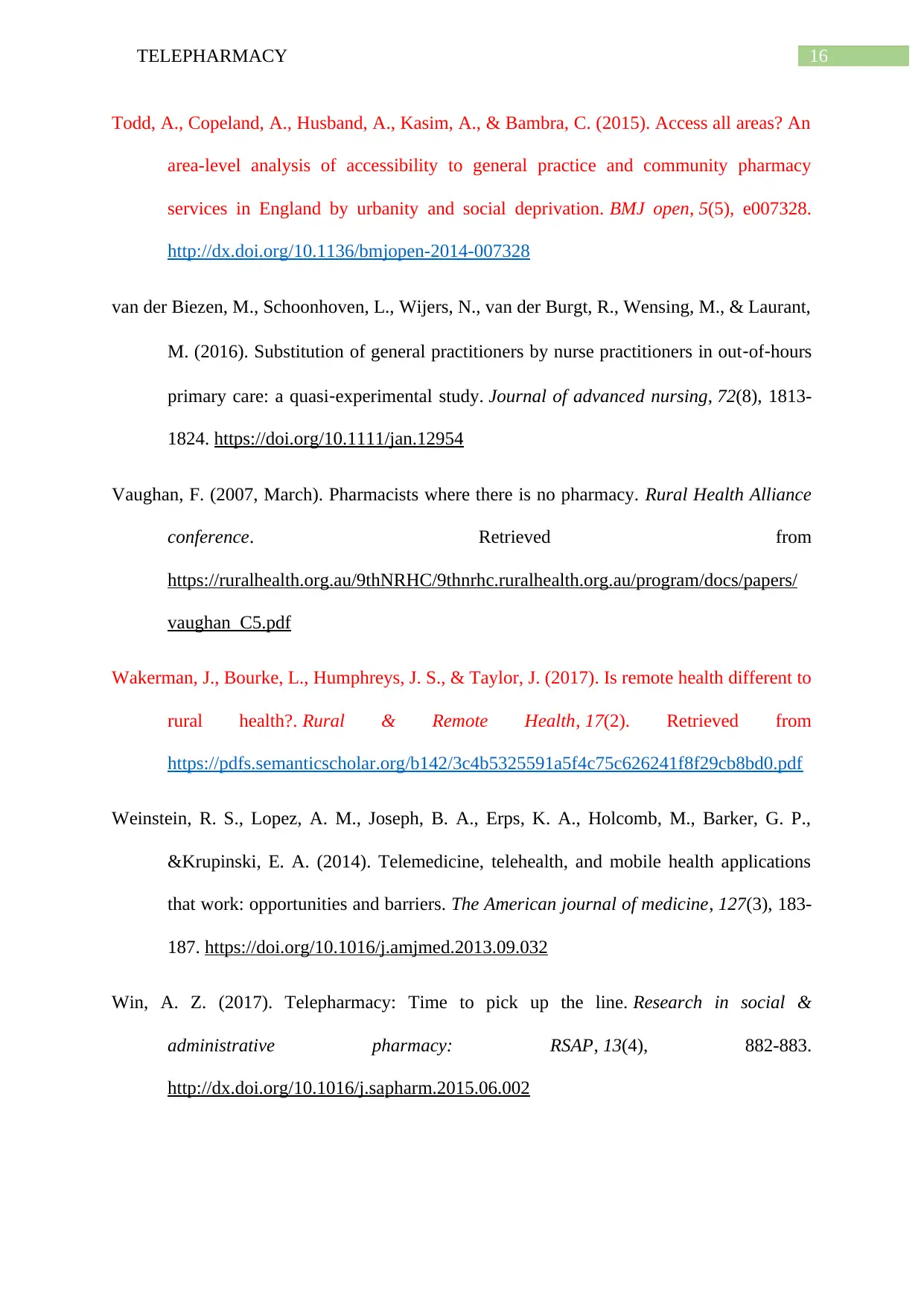
16TELEPHARMACY
Todd, A., Copeland, A., Husband, A., Kasim, A., & Bambra, C. (2015). Access all areas? An
area-level analysis of accessibility to general practice and community pharmacy
services in England by urbanity and social deprivation. BMJ open, 5(5), e007328.
http://dx.doi.org/10.1136/bmjopen-2014-007328
van der Biezen, M., Schoonhoven, L., Wijers, N., van der Burgt, R., Wensing, M., & Laurant,
M. (2016). Substitution of general practitioners by nurse practitioners in out‐of‐hours
primary care: a quasi‐experimental study. Journal of advanced nursing, 72(8), 1813-
1824. https://doi.org/10.1111/jan.12954
Vaughan, F. (2007, March). Pharmacists where there is no pharmacy. Rural Health Alliance
conference. Retrieved from
https://ruralhealth.org.au/9thNRHC/9thnrhc.ruralhealth.org.au/program/docs/papers/
vaughan_C5.pdf
Wakerman, J., Bourke, L., Humphreys, J. S., & Taylor, J. (2017). Is remote health different to
rural health?. Rural & Remote Health, 17(2). Retrieved from
https://pdfs.semanticscholar.org/b142/3c4b5325591a5f4c75c626241f8f29cb8bd0.pdf
Weinstein, R. S., Lopez, A. M., Joseph, B. A., Erps, K. A., Holcomb, M., Barker, G. P.,
&Krupinski, E. A. (2014). Telemedicine, telehealth, and mobile health applications
that work: opportunities and barriers. The American journal of medicine, 127(3), 183-
187. https://doi.org/10.1016/j.amjmed.2013.09.032
Win, A. Z. (2017). Telepharmacy: Time to pick up the line. Research in social &
administrative pharmacy: RSAP, 13(4), 882-883.
http://dx.doi.org/10.1016/j.sapharm.2015.06.002
Todd, A., Copeland, A., Husband, A., Kasim, A., & Bambra, C. (2015). Access all areas? An
area-level analysis of accessibility to general practice and community pharmacy
services in England by urbanity and social deprivation. BMJ open, 5(5), e007328.
http://dx.doi.org/10.1136/bmjopen-2014-007328
van der Biezen, M., Schoonhoven, L., Wijers, N., van der Burgt, R., Wensing, M., & Laurant,
M. (2016). Substitution of general practitioners by nurse practitioners in out‐of‐hours
primary care: a quasi‐experimental study. Journal of advanced nursing, 72(8), 1813-
1824. https://doi.org/10.1111/jan.12954
Vaughan, F. (2007, March). Pharmacists where there is no pharmacy. Rural Health Alliance
conference. Retrieved from
https://ruralhealth.org.au/9thNRHC/9thnrhc.ruralhealth.org.au/program/docs/papers/
vaughan_C5.pdf
Wakerman, J., Bourke, L., Humphreys, J. S., & Taylor, J. (2017). Is remote health different to
rural health?. Rural & Remote Health, 17(2). Retrieved from
https://pdfs.semanticscholar.org/b142/3c4b5325591a5f4c75c626241f8f29cb8bd0.pdf
Weinstein, R. S., Lopez, A. M., Joseph, B. A., Erps, K. A., Holcomb, M., Barker, G. P.,
&Krupinski, E. A. (2014). Telemedicine, telehealth, and mobile health applications
that work: opportunities and barriers. The American journal of medicine, 127(3), 183-
187. https://doi.org/10.1016/j.amjmed.2013.09.032
Win, A. Z. (2017). Telepharmacy: Time to pick up the line. Research in social &
administrative pharmacy: RSAP, 13(4), 882-883.
http://dx.doi.org/10.1016/j.sapharm.2015.06.002
1 out of 17
Related Documents
Your All-in-One AI-Powered Toolkit for Academic Success.
+13062052269
info@desklib.com
Available 24*7 on WhatsApp / Email
![[object Object]](/_next/static/media/star-bottom.7253800d.svg)
Unlock your academic potential
© 2024 | Zucol Services PVT LTD | All rights reserved.



